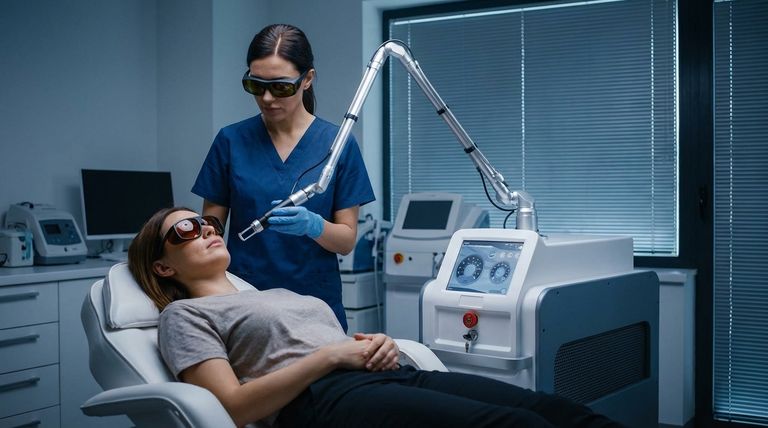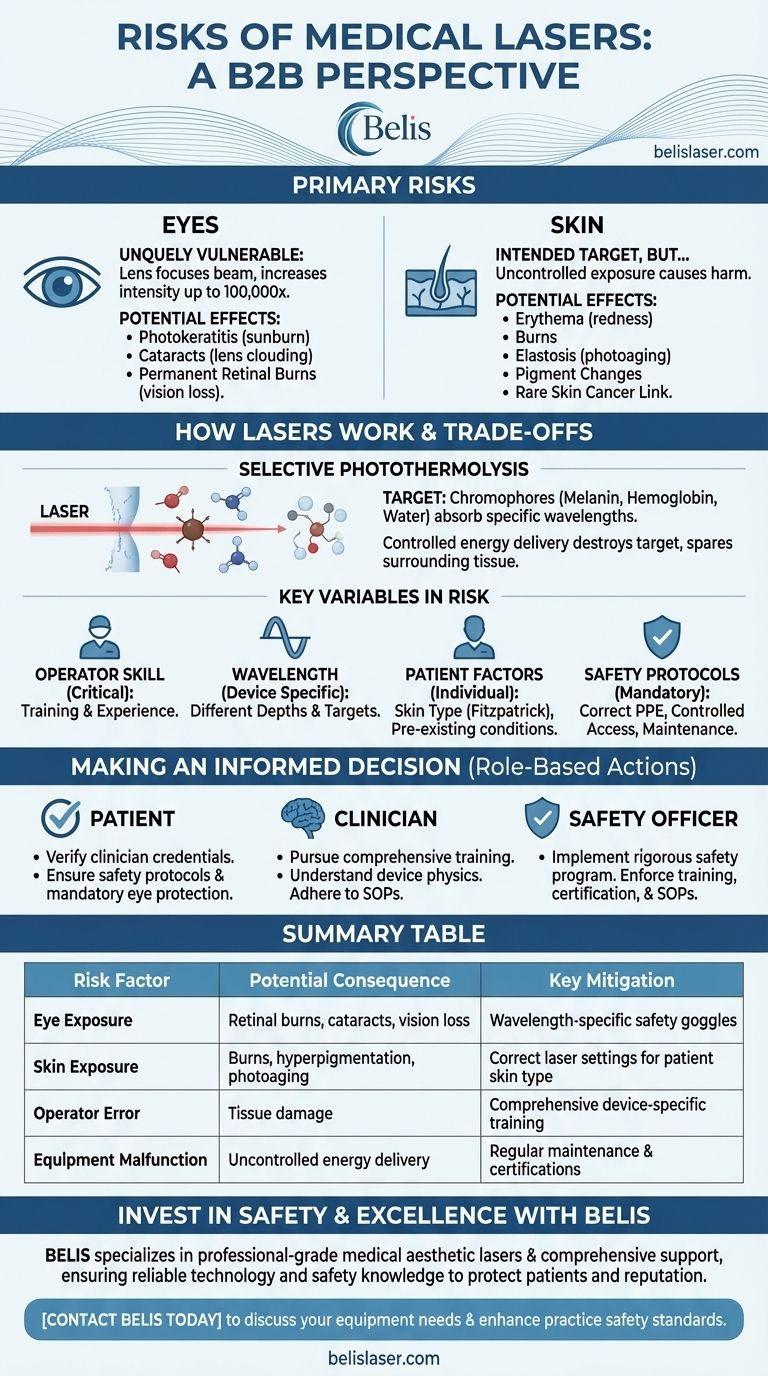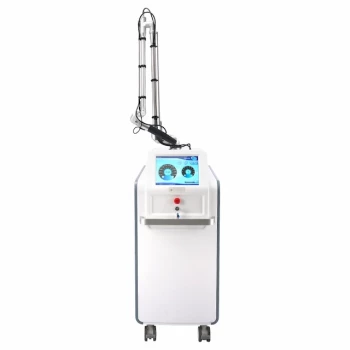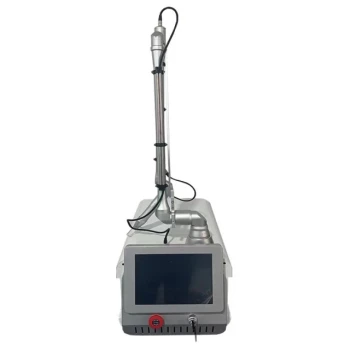In short, the primary risks associated with medical lasers are direct tissue damage, specifically to the eyes and skin. For the skin, this can range from temporary redness and burns to long-term issues like photoaging or, in rare cases, promoting skin cancer. For the eyes, the effects are particularly severe, including corneal or retinal burns, cataracts, and potentially permanent vision loss.
The potential for harm from a medical laser is not a random event. It is a predictable outcome based on the physics of the laser, the properties of the tissue, and the protocols in place, making risk almost entirely manageable through expertise and procedural discipline.

How Lasers Interact with Biological Tissue
To understand the risks, you must first understand how a focused beam of light causes a biological effect. The entire principle of medical laser therapy relies on a controlled and targeted delivery of energy.
The Principle of Selective Photothermolysis
Medical lasers work by targeting specific molecules in the body called chromophores. These are molecules that absorb light of a particular wavelength.
Common targets include melanin (in skin and hair), hemoglobin (in blood vessels), and water (in all tissues). When the chromophore absorbs the laser energy, it rapidly heats up and is destroyed, leaving surrounding tissue largely unaffected.
Primary Risk Zone: The Eyes
The eye is uniquely vulnerable because its lens can focus a laser beam onto the retina, increasing its intensity by up to 100,000 times. This is why eye damage is the most significant risk.
Potential effects include photokeratitis (inflammation of the cornea, like a sunburn), cataracts (clouding of the lens), and permanent retinal burns leading to blind spots or complete vision loss.
Secondary Risk Zone: The Skin
The skin is the intended target for many procedures, but uncontrolled exposure can cause harm.
Risks range from mild erythema (redness) to severe burns. Over longer terms, improper exposure can accelerate elastosis (photoaging) or cause pigment changes. While direct causation is complex, any energy source that damages skin cells carries a theoretical risk related to skin cancer.
Understanding the Trade-offs and Key Variables
Risk is never zero in any effective medical procedure. The key is to understand the factors that increase or decrease that risk.
Operator Skill is the Critical Factor
The single most important variable in laser safety is the training, knowledge, and experience of the person operating the device. An expert understands how to adjust parameters for a specific patient and condition, while an untrained operator can easily cause significant harm.
Not All Lasers Are Equal
Different laser wavelengths penetrate to different depths and are absorbed by different chromophores. A laser designed for hair removal (targeting melanin) has a different risk profile than one used for skin resurfacing (targeting water).
Patient Factors Matter
A patient's skin type (e.g., using the Fitzpatrick scale) is a crucial factor. Darker skin has more melanin and is at a higher risk of burns or pigment changes if the wrong laser or setting is used. Pre-existing conditions and medications can also affect a patient's response to treatment.
The Role of Safety Protocols
Strict adherence to safety protocols mitigates the vast majority of risk. This includes using the correct Personal Protective Equipment (PPE), especially wavelength-specific safety goggles for both the operator and the patient. It also involves controlled access to the treatment room and regular equipment maintenance.
Making an Informed Decision
Your approach to managing laser risk depends on your role. The constant is that knowledge and adherence to standards are the foundations of safety.
- If you are a patient: Your primary focus is verifying the credentials and experience of the clinician and ensuring the facility follows clear, stated safety protocols, including mandatory eye protection.
- If you are a clinician: Your responsibility is to pursue comprehensive training, understand the physics of your specific device intimately, and never deviate from established safety protocols.
- If you are a safety officer or practice manager: Your goal is to implement and enforce a rigorous safety program, including training, equipment certification, and clear standard operating procedures (SOPs).
Ultimately, medical lasers are powerful tools whose risks are well-understood and can be effectively controlled through expertise, diligence, and an unwavering commitment to safety.
Summary Table:
| Risk Factor | Potential Consequence | Key Mitigation |
|---|---|---|
| Eye Exposure | Retinal burns, cataracts, permanent vision loss | Mandatory, wavelength-specific safety goggles |
| Skin Exposure | Burns, hyperpigmentation, photoaging | Correct laser settings for patient skin type (Fitzpatrick scale) |
| Operator Error | Improper treatment leading to tissue damage | Comprehensive, device-specific training and experience |
| Equipment Malfunction | Uncontrolled energy delivery | Regular maintenance and safety certifications |
Invest in Safety and Excellence with BELIS
Mitigating laser risk starts with using professional-grade equipment managed by trained experts. BELIS specializes in providing top-tier medical aesthetic lasers and comprehensive support for medical aesthetics clinics and premium beauty salons. We ensure your practice is equipped with reliable technology and the knowledge to use it safely, protecting your patients and your reputation.
Contact BELIS today to discuss your equipment needs and enhance your practice's safety standards.
Visual Guide

Related Products
- Pico Laser Tattoo Removal Machine Picosure Picosecond Laser Machine
- Pico Picosecond Laser Machine for Tattoo Removal Picosure Pico Laser
- Q Switch Nd Yag Laser Machine Tattoo Removal Nd Yag Machine
- Diode Laser SHR Trilaser Hair Removal Machine for Clinic Use
- Multifunctional Laser Hair Growth Machine Device for Hair Growth
People Also Ask
- What is the disadvantage of Pico laser treatment? Understand the Risks and Costs Before You Decide
- What does Pico do for skin? Unlock Non-Invasive Skin Rejuvenation
- Who should not do pico laser? Key Contraindications for Safe Treatment
- How much does a laser tattoo removal machine cost? Choose the Right Tech for Your Clinic
- What is the case of most adverse reactions after laser? Prevent Post-Inflammatory Hyperpigmentation



















